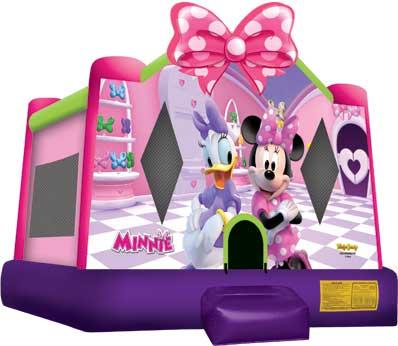About to bounce inflatables and bounce house safety
Welcome to About to Bounce!
Bounce House Safety
What parents can do for a safe bounce house experience.Bounce House Safety Information
Parents don't have to rule out bounce house fun, but they do need to take steps to keep kids safe. The key for parents is understanding and being aware of the three Ws of bounce house safety ... weather, workers and warranty.
The first W is for Weather
Wind is "the number one enemy" of an inflatable and can cause it to become dangerous. Most manufacturers recommend removing children from bounce houses and/or deflating them when winds are 20 to 25 miles per hour or higher. Obviously, most parents aren't going to have a wind gauge on them, so an easy rule of thumb for people. ... When your clothes are flapping like a flag, that is a really good, simple indicator to understand, that the winds are picking up. The kids might cry when you tell them they need to come out of the bounce house, but tears are preferable to an incident.
The second W is for WorkersInflatable Safety Information
The people who are operating the bounce house. A lot of people, especially some of the newer operators who have just gotten into the business, don't understand how the inflatable should be anchored to the ground. Make sure your rental company has a successful track record. Check this; If they are using using 4- or 5-inch plastic stakes, They probably don't know what they're doing. Professional operators would use "30- to 40-inch heavy-duty metal stakes. It's lack of judgment that almost always causes the problem, not using proper anchoring or supervision of the situation.
Parents should make sure there is an operator present at the bounce house.
Most parents wouldn't let their kids go on a roller coaster if it doesn't have an attendant, and you probably wouldn't let your kid go in the swimming pool unattended. So why would you let your kid get into a bounce house or a slide or any inflatable that is unattended?
Only kids of the same size should be inside together and most inflatables will have rules stitched on the outside detailing the maximum occupancy.
Bounce House Safety TipsParents need to watch what's happening too, especially if they rent a bounce house themselves. Inflatables aren't baby sitters. Sometimes, people look at it that way. It's kind of like the swimming pool. You're not going to leave that unsupervised. You should never leave an inflatable unsupervised.
The third "W" stands for warranty.
Parents need to ask the operator to see the company's current insurance policy and state inspections. Now, this gets somewhat complicated. There are no national inspection guidelines or regulations for bounce houses. Inspections are left up to the states. Some have thorough inspection programs, and some have none at all, but parents can inquire with the operator or the manufacturer to learn about inspections to the bounce houses and to get more of a sense of a company's reputation.
If parents use common sense and remember those three Ws, weather, workers and warranty, they will go a long way toward helping make the bounce house as fun and safe as it's intended to be. Parents should also make sure operators are focusing on what's happening inside the bounce house, not outside.
Here are some tips from the Child Injury Prevention Alliance
INJURY PREVENTION TIPS
Limit bouncer use to children 6 years of age and older.
Only allow a bouncer to be used when an adult trained on safe bouncer use is present.
The safest way to use a bouncer is to have only one child on it at a time.
If more than one child will be on the bouncer at the same time, make sure that the children are about the same age and size (weight).
PROPER USE
Take off shoes, eyeglasses and jewelry and remove all sharp objects from your pockets before entering the bouncer.
No rough play, tumbling, wrestling or flips. Stay away from the entrance or exit and the sides or walls of the bouncer while you are inside of it.
If the bouncer begins to lose air, stop play and carefully exit the bouncer.
SETTING UP AN INFLATABLE BOUNCER
Outside set up:
Place the bouncer on a flat surface.
Remove all rocks, sticks or objects such as sprinkler systems sticking up from the ground before setting up the bouncer.
Make sure there is open space around all sides of the bouncer.
Place the bouncer away from tree branches or power lines.
If the bouncer will be set up on a hard surface, place a soft surface around the entrance/exit to the bouncer.
Inside set up:
Only set up bouncers in rooms where the ceiling is several feet above the top of the bouncer.
Place the bouncer away from walls.
If the bouncer will be set up in a room with hard floors, place a soft surface around the entrance/exit to the bouncer.
Follow these simple guidelines and you and your children will be on your way to healthy, bouncing day!

